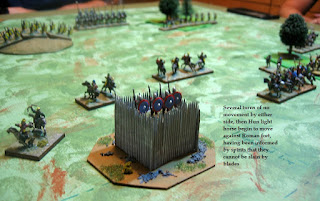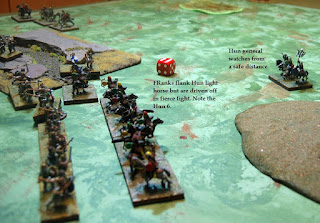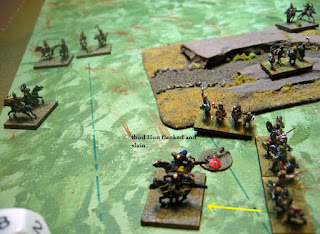I was poking
through my stack of rules recently and came across my old dog-eared, battered
copy of these rules. The red paperback cover
features truly amateurish sketches, a long stretch from the current hard cover
coffee-table rules.
Back in the 70’s I had a lot of fun using these. They
produced a game that had an elegant feel not seen in other rules since, though
they had some distinct problems. They were a welcome change of pace after we
went through a period playing Napoleonique. One reason the latter games were a
pain to play was because we took rules aimed at a division per side and crammed
three per side in Gerry’s basement in Brooklyn. Using way more troops than the game was designed to handle is often a bad idea. But we were young and had loads of figures.
The WRG rules were used on a table in Rick’s apartment with a reinforced
division per side. We soon were able to play games at about 15 minutes per
turn. Our games in the Napoleonic period worked well enough. Straying into the
American Revolution yielded some strange results. Our one attempt at a South
American War of Independence battle was hilarious but not
a real game. We played a couple games based on my dim understanding of the 1848
Revolutions. These eventually led to the design of Junta. But that’s another
tale.
The WRG
rules were published in 1971 and like most rules of that period had a specific
basing scheme for 25mm figures, 15mm per line infantry, 25mm per light
infantry/heavy cavalry, 30mm per light cavalryman and 75mm for artillery
sections. The scale was 10 paces to the inch, which led to artillery ranges of
120 to 150 inches and canister at 30 inches. Musket range was 12 inches.
Artillery could fire clear across most tables, perhaps even hit people in the
next room.
The turn
sequence was: write orders, declare charges, simultaneous movement, resolve firing, resolve melees, resolve morale issues due to routs, losses, etc.
Firing and
melee used a table similar to the one in the WRG Ancient rules. You
cross-indexed the number of figures firing or fighting with the factor plus the
die roll. Every 15 hits removed a figure. Critical to the system was the number
of casualties per figure. Each one was a flinch point. There were others, like
being flanked or having friends rout, etc. The unit with more flinch points
than their enemy became disordered and backed up 3 inches per extra flinch,
breaking if there were many. This made for some very interesting results. In many other rules, a unit is either following orders or has failed morale. Flinching a good
distance away from the enemy wasn’t all that bad. Flinching while in close
proximity left one open to being routed. This is what made the game. You could
break a unit and all their nearby friends would flinch. If you had another unit
in good order close at hand you could rout one of these on the next turn,
causing the others to flinch again. Meanwhile your first attacking unit could
rally and dress ranks. Three well-coordinated units could keep an attack going
when all was well. Units ignored the routs of lesser friends, so having a better
class unit in reserve was one way to break up such an attack. If you broke the
cycle most of the routed units would rally. This gave a flavor I’ve not seen in
other rules.
On the down
side, the orders system was vague and liable to misuse. The points system, like
most, was not all that great. Being young, we assumed that the semi-scientific
name of the publishing group insured everything about the rules was scientific.
Sure, right. Light infantry was the strongest thing in the game. Since they
were based differently, we only used them in something resembling the correct
proportions. But if you wanted to win, history be damned, the way to victory was to field all light infantry.
Deployed
light infantry in open order could shoot cavalry charges into the ground. Trained and elite line infantry could do the same. Post 1783, infantry had to form square when
cavalry arrived within charge distance. This had an incredible effect, slowing
infantry attacks. Once a superior officer gave orders to advance, the infantry
could form line and advance with loaded muskets on those foolish horsemen.
We tried the
rules for the American Revolution. WRG said to rate American militia as poorly
trained light infantry. In a straight firefight they could decimate line
infantry. One of the few games of this saw poorly trained light dragoons ride
down Tory militia. But it wasn’t until we put a South American game on the
table that our eyes were opened. WRG said to field all units as poorly trained
variants of European types. (These days I would disagree with that.) A game
with numerous infantry and a reasonable amount of cavalry revealed that poorly trained
infantry in the open was helpless against poorly trained cavalry. Within a
couple turns most of the infantry on both sides had been chased off the table
by the cavalry regiments present. I suspect the designers had used trained British
and Sepoy troops against Indian Princely forces and found it working, more or
less. I can’t believe they actually put a South American game on the table. The
final blow against these rules came during a game of French levee-en-masse
troops against a smaller force of trained troops. The rules handled a single column
against a single line unit quite well. But two columns of conscripts against a
single line unit could not be stopped. It was obvious this would also be true
for trained troops, destroying the balance in our games. That put an end to using
these rules.
Many other
Napoleonic rules have the problem of the massed column phalanx. It moves faster
than line and cannot be stopped. It is worthy of note that similar massed
infantry formations failed at Waterloo
Anyway, the
games provided much entertainment until we came up against the limitations. Looking
at the rules now, I note a certain lack of clarity. Some disorganized units
must rally before they can advance against the enemy again. A good number don’t
have to. Now that my age-acquired wisdom notices this sort of stuff, I can’t recall
which units were disorganized by charging or pursuing or being in melee, and
which were disorganized by seeing friends rout or moving through rough terrain
or over an obstacle, etc. Ah, but while it was good, it was very good. It might
have had a lot to do with being young.
Edit: the rules can be found here.




















































